Tashkent - Bukhara - Samarkand - Urgench (Khiva)
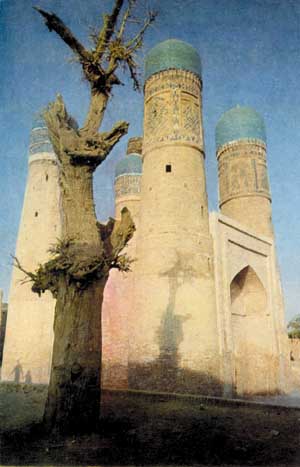
Tashkent is one of the most beautiful and ancient in Central Asia. It is located in the fertile valley of Fergana on the banks of the Cherchik River.
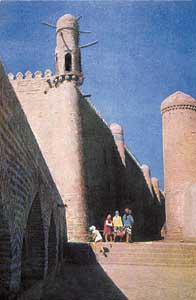 |
Founded more that two thousand years ago, Tashkent developed rapidly in the Middle Ages due to its advantageous location on the site where different trade routes from Eastem Europe to Asia and India as well as from Siberia to the Middle East crossed. Tashkent today is the city with wide streets, numerous squares, parks, gardens, fountains and multistoried apartment houses. The city has a population of more than 2 million. The preserved architectural monumets date back largely to the Middle Ages: medresse Kukeldash and Barach-Chan, Kaffal-Shoshi mausoleum and Dshami mosque. Rich collections of numerous city museums are worth to be mentioned. Among those is the Museum of Applied and Decorative Art where one can see lots of old exhibits, including the Bukhara rugs made of golden thread, known far beyond the borders of Central Asia. |
Bukhara is one of the ancient cities in Central Asia. Its mosques and minarets have witnessed 2500 years of history. Together with Samarkand and Khiva the city contributed to the development of Central Asia, comprising “the Great Triange of the East.”
There is a supposition that the word “Bukhara” is derived from the word “Vikhara.”
During the centuries, Bukhara was invaded many times. From the 6th century to the 19th century the city was the capital of Bukhar Khan. Persians, Macedonians, Arabs, Genghis Khan’s hordes marched through its ancient streets. Bukhara was the most important check point in the Great Silk Way. All these historie events are reflected in Bukhara cultural background. |
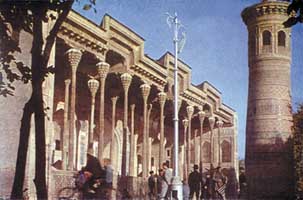 |
Among140 Bukhara monuments, the oldest are the Ark Fortress and Ismail Samani Mausoleum (the end of the 9th—10th centuries).
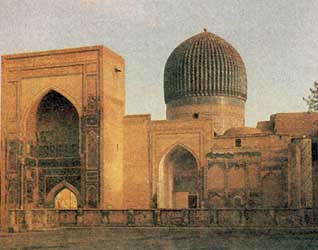 |
Samarkand is one of the oldest cities in the world. It was founded in the 5th centure B. C. The city is well known for its architectural monuments. It is a town-museum with famous splendors of medieval Moslem architecture. The excavations on the outskirts of Samarkand revealed the mystery of its foundation. 25 centuries ago it was the capital of the powerful state of Sogdiana. In 1369 the great conqueror Timur made it the capital of his vast empire. The unique beauty of the monuments created by Timur and his successors still evokes admiration and wonder. |
Placed on the slope of the Afrasiab mound like a blue neckless there is the ensemble of Shak-i-Zindeh. Its chain of small ornate mausoleums dating from different centuries makes it a masterpiece of unequalled craftsmanship. Close to the ancient bazar rise the magnificent ruins of the 14th century huge mosque of Bibi-Khanym. The 15th centure Gur Emir. The tomb of Tunur is decorated with turquoise-colored dome shaped as a tulip bud faced with glazed tiles.
Here in Samarkand there is a famous observatory of the great astronomer and scholar Ulugbek which was built in the 15th century. Pendjikent with the ruins of ancient town of Sogdiana, a unique monument of pre-Islamic culture of Central Asia is situated 68 km from Samarkand. During the archaeological excavations a number of samples of pottery, metal work and glass as well as many ancient coins were discovered. Due to those findings the town became known as the Pompeii of Central Asia. |
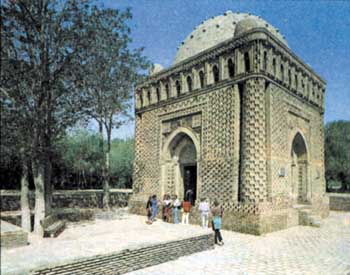 |
Urgench is located in the North West of the Usbek Republic in Khoresm basin. It was founded in the second half of the 19th century. Today it is the administrative and cultural center of Khorezm Region.
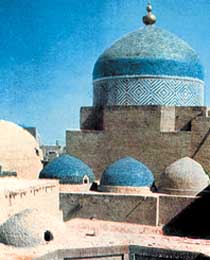 |
A lot of tourists come to the town to visit a reserve-city of Khiva (30 km from Urgench). The first record of Khiva was made in the 10th century. It became the capital of Khiva Khanate in the 16th century. The city consists of two parts: the internal reserve-city and the extermal city which still has many Uzbek monuments and museums. The most impressive and unique monuments are Medresse of Mukhamed-Amin-Khan (1850—1854), Kunya-Ark (old fortress of the 18th century), Mausoleum of Said-Allaudin-monument of the Mongolian period (the 14th century, Dzuma-mosque, Sarai-bazar, Caravanserai, ets. |
Transfers
Tashkent
| Tashkent Destination | Alfa-Romeo (3 pax) | Mazda (5-7 pax) | Mitsubishi (14-17 pax) | Toyota Coaster (14-17 pax) | TAM (40 pax) |
| City rate (1 hour) | 13 | 15 | 19 | 22 | 39 |
| Out-of-town (1 hour) | 15 | 18 | 21 | 27 | 41 |
| 1 Day (20 hours) | 286 | 352 | 352 | 422 | 814 |
Samarkand
| Samarkand Destination | Volga-GAZ 24 (3 pax) | Nissan-Urban (5-7 pax) | TAM (40 pax) |
| City rate (1 hour) | 11 | 16 | 27 |
| Out-of-town (1 hour) | 14 | 18 | 29 |
| 1 Day (20 hours) | 264 | 352 | 572 |
Bukhara
| Bukhara Destination | Volga-GAZ 31 (3 pax) | Toyota (5-7 pax) | Toyota Coaster (14-17 pax) | Hundai (40 pax) |
| City rate (1 hour) | 9 | 14 | 21 | 27 |
| Out-of-town (1 hour) | 14 | 17 | 26 | 29 |
| 1 Day (20 hours) | 264 | 330 | 506 | 572 |
| Flight | Economy | Business |
| Tashkent-Bukhara | 69 USD | 85 USD |
| Tashkent-Samarkand | 58 USD | 75 USD |
Guide Service
| Guide Service | Tashkent | Bukhara | Samarkand |
| USD/hour | 8 | 5 | 6 |
See also:
The main tourist centres and attractions
of Russia
The main tourist centres and attractions
of C.I.S countries
tourist centres || email || contact || main page